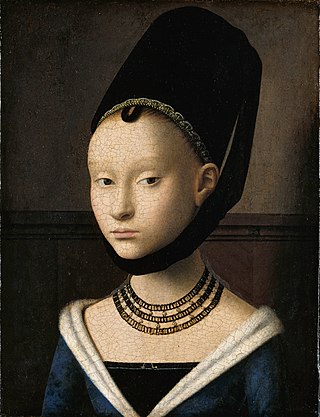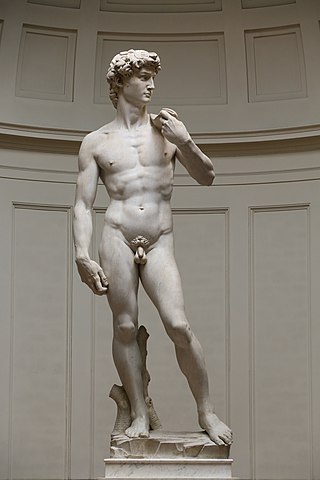
In art, chiaroscuro is the use of strong contrasts between light and dark, usually bold contrasts affecting a whole composition. It is also a technical term used by artists and art historians for the use of contrasts of light to achieve a sense of volume in modelling three-dimensional objects and figures. Similar effects in cinema, and black and white and low-key photography, are also called chiaroscuro.

Balthild, also spelled Bathilda, Bauthieult or Baudour, was queen consort of Neustria and Burgundy by marriage to Clovis II, the King of Neustria and Burgundy (639–658), and regent during the minority of her son, Chlothar III. Her hagiography was intended to further her successful candidature for sainthood.

Fashion in the years 1750–1775 in European countries and the colonial Americas was characterised by greater abundance, elaboration and intricacy in clothing designs, loved by the Rococo artistic trends of the period. The French and English styles of fashion were very different from one another. French style was defined by elaborate court dress, colourful and rich in decoration, worn by such iconic fashion figures as Marie Antoinette.

Portrait of a Young Girl is a small oil-on-oak panel painting by the Early Netherlandish painter Petrus Christus. It was completed towards the end of his life, between 1465 and 1470, and is held in the Gemäldegalerie, Berlin. It marks a major stylistic advance in contemporary portraiture; the girl is set in an airy, three-dimensional, realistic setting, and stares out at the viewer with a complicated expression that is reserved, yet intelligent and alert.

Take Your Son, Sir! (1851–1956) is an unfinished painting by the British artist Ford Madox Brown that depicts a woman showing her newborn son to its father. She is offering her baby towards the viewer of the painting, who is implicitly equated with the father – seen in the mirror behind, opening his arms to receive the baby. The mirror also forms a halo behind the mother's head, and the pattern on the wallpaper suggests the starry heavens. Brown's principal influence was Jan van Eyck's painting the Arnolfini Marriage Portrait, which had recently been acquired by the National Gallery. The mirror resembles the circular mirror in van Eyck's painting, which reflects an image of the artist looking at the couple in the image.

Hairwork, or jewelry or artwork made of human hair, has appeared throughout the history of craft work, particularly to be used for private worship or mourning. From the Middle Ages through the early twentieth century, memorial hair jewelry remained common. Hair, considered to be a remnant off the person it was cut from, also has often played a part in myths and legends; in a Swedish book of proverbs, one can read that “rings and bracelets of hair increase love”. One example can be found in Denmark, at Rosensborg’s palace, which is a bracelet of precious metal with a simple braided lock of hair - a gift from King Christian IV (1577-1648) to his queen. Another example would be the rings commemorating the execution of King Charles I of England (1600-1649), which circulated among his faithful supporters. Other famous people who owned hair jewelry include Napoleon, Admiral Nelson, Queen Victoria and her large family, Christina Nilsson and Jenny Lind.

The nude, as a form of visual art that focuses on the unclothed human figure, is an enduring tradition in Western art. It was a preoccupation of Ancient Greek art, and after a semi-dormant period in the Middle Ages returned to a central position with the Renaissance. Unclothed figures often also play a part in other types of art, such as history painting, including allegorical and religious art, portraiture, or the decorative arts. From prehistory to the earliest civilizations, nude female figures were generally understood to be symbols of fertility or well-being.

Robert Peake the Elder was an English painter active in the later part of Elizabeth I's reign and for most of the reign of James I. In 1604, he was appointed picture maker to the heir to the throne, Prince Henry; and in 1607, serjeant-painter to King James I – a post he shared with John De Critz.

Sigismunda mourning over the Heart of Guiscardo, fully titled Sigismunda mourning over the Heart of Guiscardo, her murder'd Husband, is an oil painting by British artist William Hogarth. Finished in 1759, it was the principal piece of the eight works he displayed in an exhibition in 1761. It was the final and most ambitious of his attempts to secure for himself a reputation as a history painter. It depicts a dramatic moment in one of the novelle in Boccaccio's Decameron. While Hogarth had expected this work to be acclaimed as a masterpiece of dramatic painting, the work was met with criticism and ridicule. In the catalogue of the exhibition of Hogarth's works at the Tate Gallery in 2007, the criticism was described as "some of the most damning critical opprobrium the artist ever suffered".

The Lictors Bring to Brutus the Bodies of His Sons is a work in oils by the French artist Jacques-Louis David. On a canvas of 146 square feet, this painting was first exhibited at the Paris Salon in 1789. The subject is the Roman leader Lucius Junius Brutus, founder of the Roman Republic, contemplating the fate of his sons. They had conspired to overthrow the republic and restore the monarchy, and Brutus himself was compelled to order their deaths. In doing so, Brutus became the heroic defender of the republic, at the cost of his own family. The painting was a bold allegory of civic virtue with immense resonance for the growing cause of republicanism. Its themes of virtue, sacrifice, and devotion to the nation sparked much controversy when it was unveiled in the politically charged era of the French Revolution.

Judith Slaying Holofernes is a painting by the Italian early Baroque artist Artemisia Gentileschi, completed in 1612-13 and now at the Museo Capodimonte, Naples, Italy.
Margaretta M. Lovell is an American art historian who serves as the Jay D. McEvoy, Jr. Professor of the History of Art at the University of California, Berkeley. Her research and teaching center on the art and history of the United States, including eighteenth- and nineteenth-century landscape painting, portraiture, decorative arts, furniture, architecture, food, and forests.

Mary Diana Lee Sheriff was an American art historian, and W.R. Kenan, Jr. Distinguished Professor of Art History at University of North Carolina at Chapel Hill who specialized in eighteenth-century French art, decorative arts, gender studies, and material culture.
Mark Louis Hallett is an English art historian specialising in the history of British art. He is the Märit Rausing Director of the Courtauld Institute of Art.
Aileen Ribeiro is a historian of fashion and author of several books about the history of costume.

Angela H. Rosenthal was an art historian at Dartmouth College and an expert on the art of Angelica Kauffman. Her masterwork was Angelica Kauffman: Art and sensibility, published by Yale University Press in 2006 which won the Historians of British Art Book Award in the pre-1800 category in 2007.

Kay Dian Kriz is professor emerita of art and architecture at Brown University. She is a specialist in British landscape painting and the visual culture of British colonialism and West Indian slavery.

Gillian Perry is professor of history of art at the Open University. She is a specialist in eighteenth century portraiture and has written two books on the actress in art. In 2011/12 she curated the exhibition The First Actresses at the National Portrait Gallery in London which was widely reviewed.
Lynda Nead is a British curator and art historian. She is currently the Pevsner Chair of the History of Art at Birkbeck, University of London. Nead's work studies British art, media, culture and often focuses on gender. Nead is a fellow of the British Academy, the Royal Historical Society and of the Academia Europaea.
Marcia Hall, who usually publishes as Marcia B. Hall, is an American art historian, who is the Laura H. Carnell Professor of Renaissance Art at the Tyler School of Art and Architecture of Temple University in Philadelphia. Hall's scholarship has concentrated on Italian Renaissance painting, mostly of the sixteenth century, and especially Raphael and Michelangelo.














